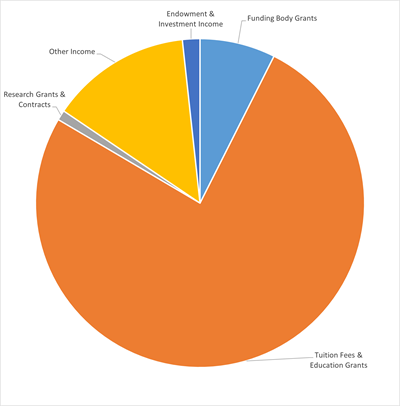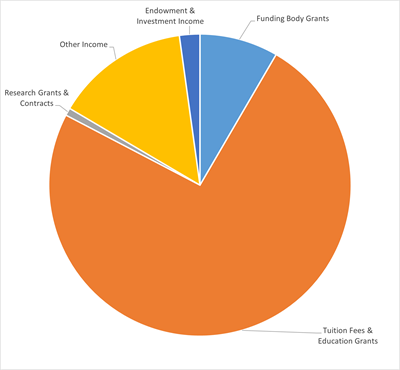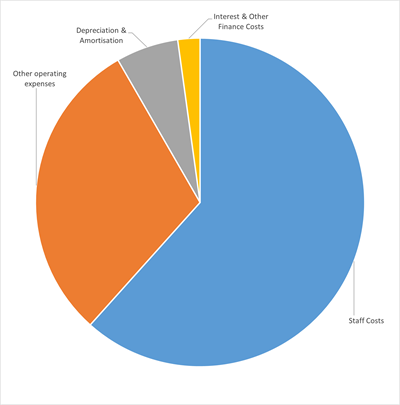University income
2024/25
University income 2024/25
| Income | £,000 |
|---|
| Funding Body Grants |
7,278 |
| Tuition Fees & Education Grants |
74,606 |
| Research Grants & Contracts |
969 |
| Other Income (1) |
13,552 |
| Endowment & Investment Income |
1,687 |
| |
98,092 |


University expenditure 2024/25
University expenditure 2024/25
| Expenditure | £'000 |
|---|
| Staff Costs |
60,438 |
| Other Operating Expenses (2) |
29,486 |
| Depreciation & Amortisation |
6,016 |
| Interest & Other Finance Costs |
2,135 |
| |
98,075 |

1. Other income
The main areas within the 'Other Income' section of the University Income chart above are as follows:
Other income
| Area | Value (£000s) |
|---|
| Student Accommodation |
£6,513 |
| Conference, Catering & Hire of Rooms |
£1,834 |
| Project & Consultancy Income - initiatives that Schools/Departments undertake for external organisations |
£629 |
| Car Parking & Permits |
£589 |
| NHS Placement income |
£1,198 |
| Community Income - including hire of sports facilities, gym membership, sports coaching courses, holiday clubs, merchandise sales |
£934 |
2. Included in other operating expenses
Included in other operating expenses
| Area | Value (£000s) |
|---|
| Grant to Students' Union |
£600 |
| Catering Expenditure - costs of providing onsite catering facilities |
£2,416 |
| Electricity, Gas & Water for all University properties including Student Accommodation |
£3,238 |
| Repairs & General Maintenance to all University property and equipment, including Student Accommodation |
£1,505 |
| Partner Colleges - cost of courses affiliated to the University, for example Halesowen College |
£2,644 |
| Student Bursaries |
£907 |
| Library Services (including the Hive) |
£1,901 |
| IT Services |
£2,289 |
Analysis of expenditure by activity
Analysis of expenditure by activity
| Area | Staff (£000s) | Other Expenses (£000s) | Totals (£000s) |
|---|
| Academic Department |
£37,692 |
£9,533 |
|
| Academic Services - staff within Learning Resources: Library Services, IT and The Hive |
£5,955 |
£6,903 |
|
| Administrative & Central Services - Staff from all the support services, including Registry, Timetabling, Student Support, Comms & External Affairs, HR, Finance etc. |
£11,357 |
£4,276 |
|
| Premises - Facilities Staff, other exp. includes utilities, maintenance |
£2,555 |
£5,460 |
|
| Research - Research staff attached to different Schools |
£1,270 |
£420 |
|
| Residences, catering and conferences - accommodation staff |
£1,609 |
£2,894 |
|
| |
£60,438 |
£29,486 |
£89,924 |
| Depreciation & Amortisation - method of allocating the cost of a tangible asset over its useful life |
|
|
£6,016 |
| Interest - cost of loans to the University for Capital Investment |
|
|
£2,135 |
| |
|
|
£98,075 |
The University’s Finances – How Do My Fees Fit In?
All universities are now encouraged to explain as transparently as possible to students both the sources of their income and how they spend their money. This is especially important now that a very large proportion of income a University receives comes from tuition fees. The information above explains where the University of Worcester receives money from and analyses the University’s expenditure. The figures relate to the 2024/25 financial year (1st August 2024 – 31st July 2025). Firstly though, we will address some of the frequently asked questions that are posed about the University’s income and expenditure.
What proportion of the University’s income derives from tuition fees?
The University’s total income in 2024/25 was £98.1m. Of this, £74.6m (76%) came in the form of tuition fees & education contracts along with £7.3m (7%) from funding body grants.
Does the University make a profit?
The University is not a private or limited company and has no shareholders, only stakeholders, which includes our students. Universities are expected to make a surplus, sufficient to allow them to invest in improving facilities, new buildings etc. 2021/22 was the first year in many, where the level of surplus (before other gains and losses) reached a substantial deficit position. Deficit positions continued for a few years, with 2024/25 seeing a return to a small surplus. The deficit (before other gains and losses) reduced from £(2.2)m in 2023/24 to a small surplus of £17k in 2024/25. This was a result of a variety of factors such as: increase in tuition fee income along with a small increase in research grants. Income from residences, catering and conferencing, reduced slightly along with funding body grants. Savings on expenditure were achieved partly as s result of the voluntary severance schemes which meant staff costs did not rise as much as they would have done, but also lower interest costs on the loans due to a large capital repayment. Procurement savings were also achieved on day to day expenditure. The fluctuations between years is due to elements of non-recurrent income, differences relating to the movement of pension liabilities, and over the last few years fluctuations in inflation.
Accounts 2024/25
Income: £98,092K
Expenditure: £98,075K
Surplus: £17K
So, from where else does the University receive its income?
The University receives around £7m in the form of funding body grants – to support expenditure on widening access and participation and additional funding for high cost subjects. Other important sources of income include research grants and contracts and a large sum which the accounts describe as “Other Income” – in 2024/25 this amounted to £13.6m. Over 40% of this comes from student accommodation, but some of this is offset by operating expenses (see below); any surplus from the leasing of student accommodation is used to fund the on-going programme of improvement and maintenance of halls of residence.
So, what does the University spend its money on?
Investing in academic staff and various academic institutes is vitally important but it accounts for only part of the University’s investment. The University is very much a community, employing over 2,000 individual staff and approx. 400 student employees and teaching more than 10,000 students. Like any community, the University needs support services – library, laboratories, specialist teaching facilities, computers and IT services, buildings, utilities, and of course a network of people to keep the University going. Every effort is made to ensure that the University achieves Value for Money in how it uses its income from tuition fees and other sources.
Value for money
Every effort is made to ensure that the University achieves Value for Money in how it uses its income from tuition fees and other sources.
An efficient and financially well-managed institution
The University of Worcester is recognised by the Office for Students as an efficient and financially well managed institution. The University spent £98m on running the University with a breakdown below. Please note the University paid £2.1m in interest in 2024/25 on loans which have been taken out in the last 20 years to fund a large proportion of the costs of the City Campus, the Arena, the Riverside Campus, new Halls of Residence, new Science Laboratories, The Hive etc., all of which have contributed to the overall quality of the student experience.
What does the University spend its money on?
| Area | £'m |
|---|
| Staff costs |
60.4 |
| Payments to Partner Colleges |
2.6 |
| Student Bursaries |
0.9 |
| Residences & General Maintenance |
4.3 |
| Books, Consumables & Laboratory expenditure |
1.4 |
| Heat, Light and Power |
3.2 |
| Depreciation |
6.0 |
| Interest |
2.1 |
| Other running costs |
17.1 |
So, the University has been investing in improving the campus and therefore the student experience then?
Very much so. The University has invested over £50m in capital improvements and new site acquisitions over the last 5 years. The level of capital investment during the year has increased from that of the previous year, which was due to the expansion of the Severn Campus, mainly the construction of the new Health and Wellbeing Teaching building (The Dukes Building), which opened in March 2025.
Capital spend by academic year
| 2024/25 | 2023/24 | 2022/23 | 2021/22 | 2020/21 |
|---|
| £9.0m |
£6.3m |
£16.2m |
£12.0m |
£7.8m |
That’s great, but what about spending on teaching and research?
The University spends approx. 60% of its income on staff costs, the overwhelming majority of which is on academic staff costs and costs relating to staff in services which relate directly to student support – Library, Information and Learning Services, Student Services, and Estates Staff who ensure that the University is a clean and safe environment in which to work and study – cleaning staff, maintenance staff, security staff, etc. In addition, £0.9m was spent on student bursaries and scholarships along with a grant of £0.6m paid to the Students Union.
So, my money is being well spent?
We think so. The University aims to give value for money to its students and to provide an experience which will allow students to flourish and to reach their full potential. We will continue to invest in the University estate and in staff and facilities.
More details
Visit our Facts and Figures page to download Annual Accounts for recent years.
If you require any further information, please contact communications@worc.ac.uk